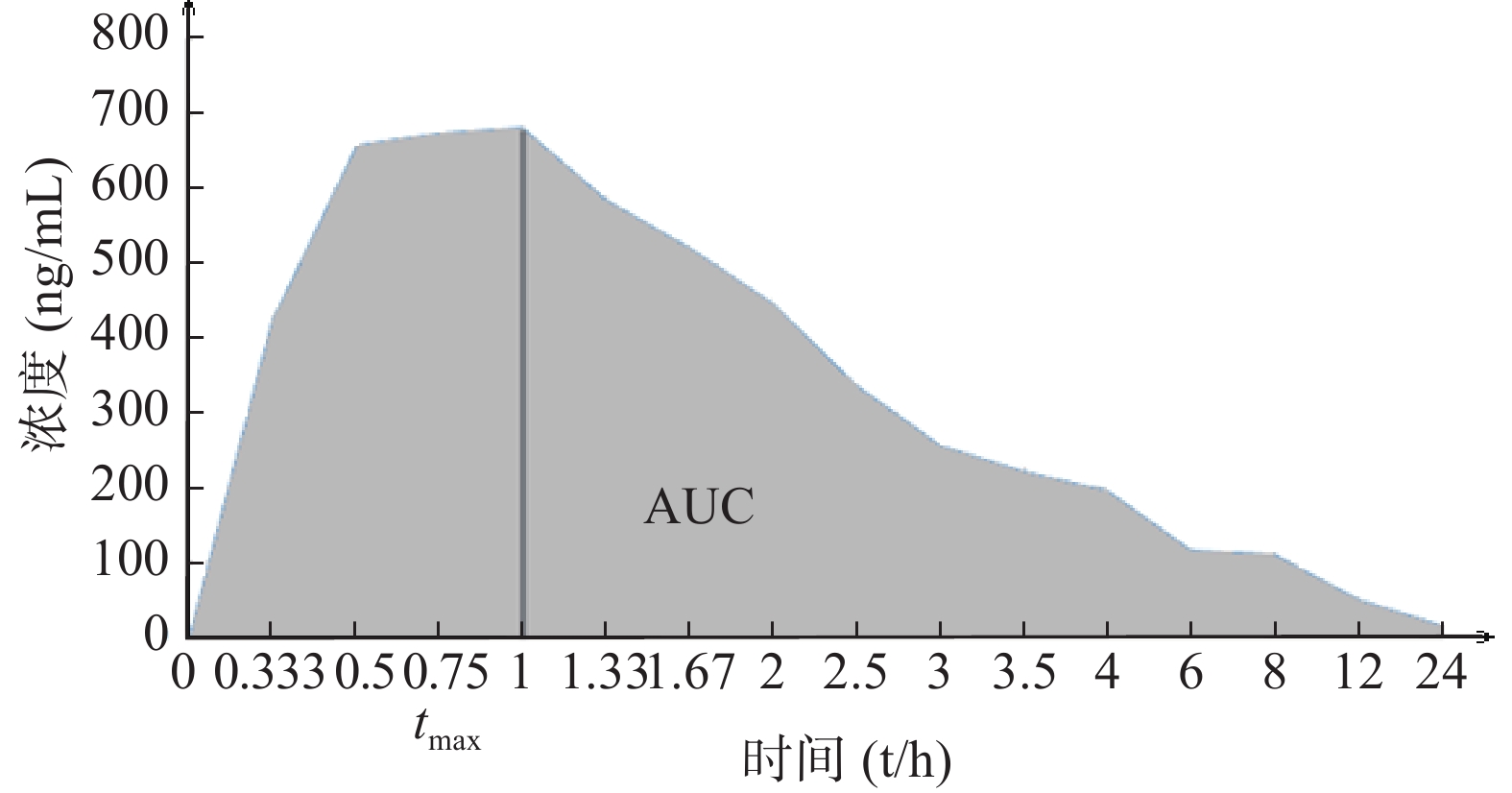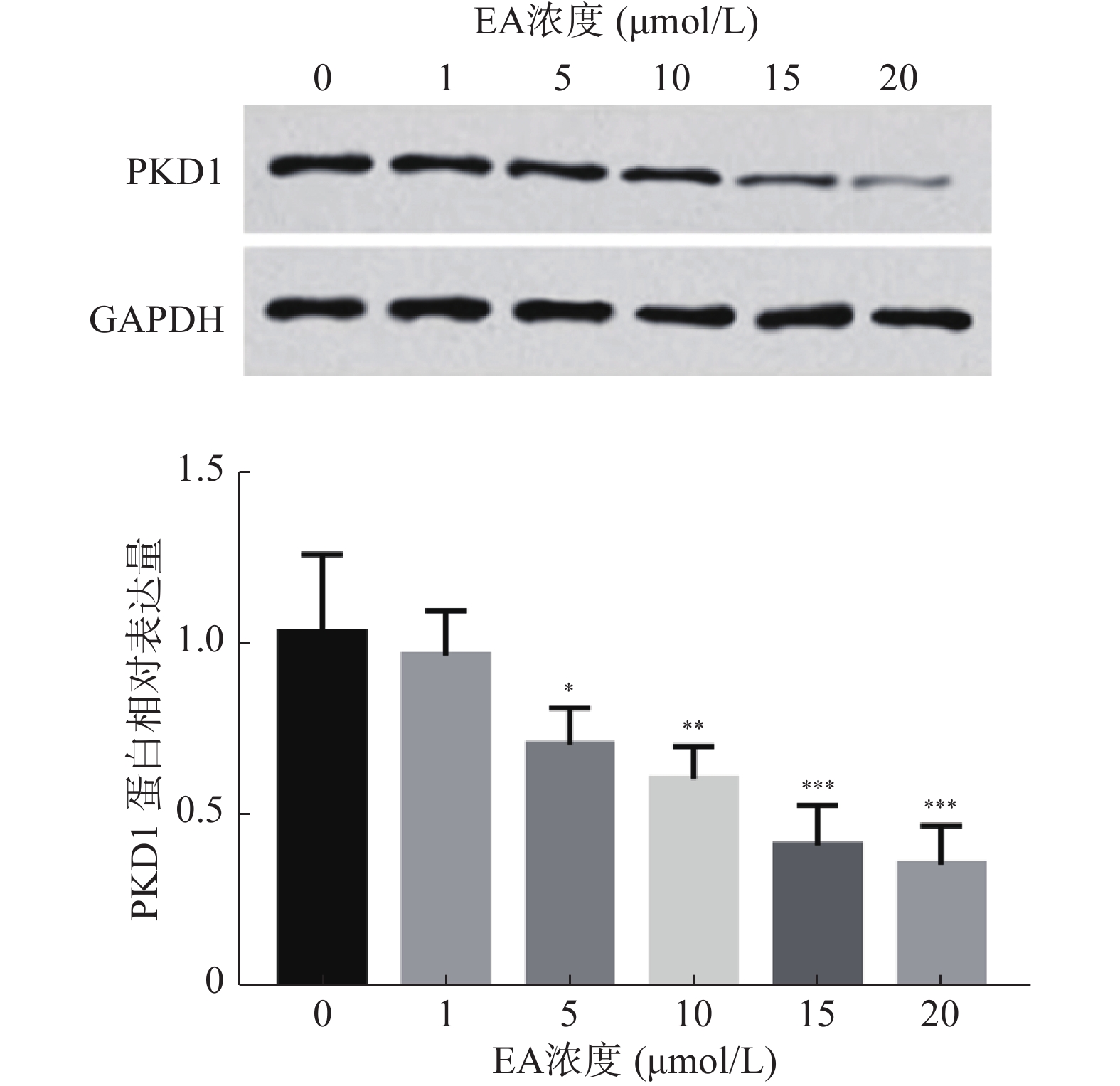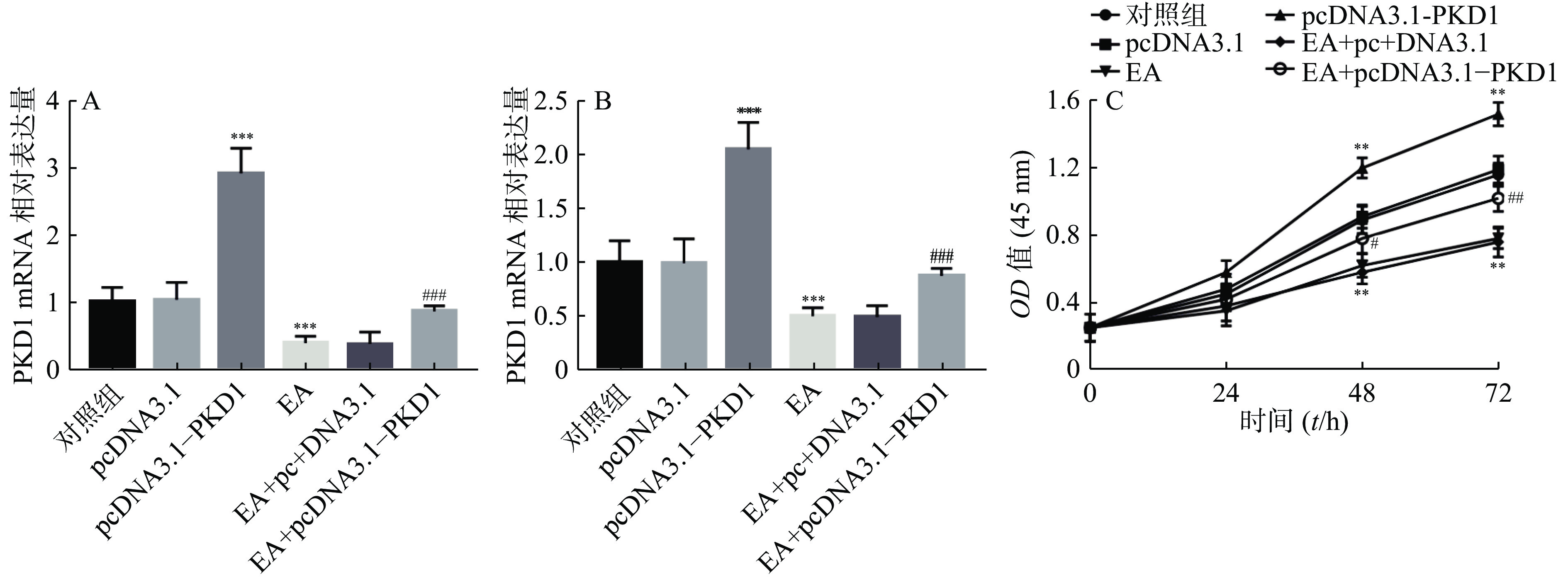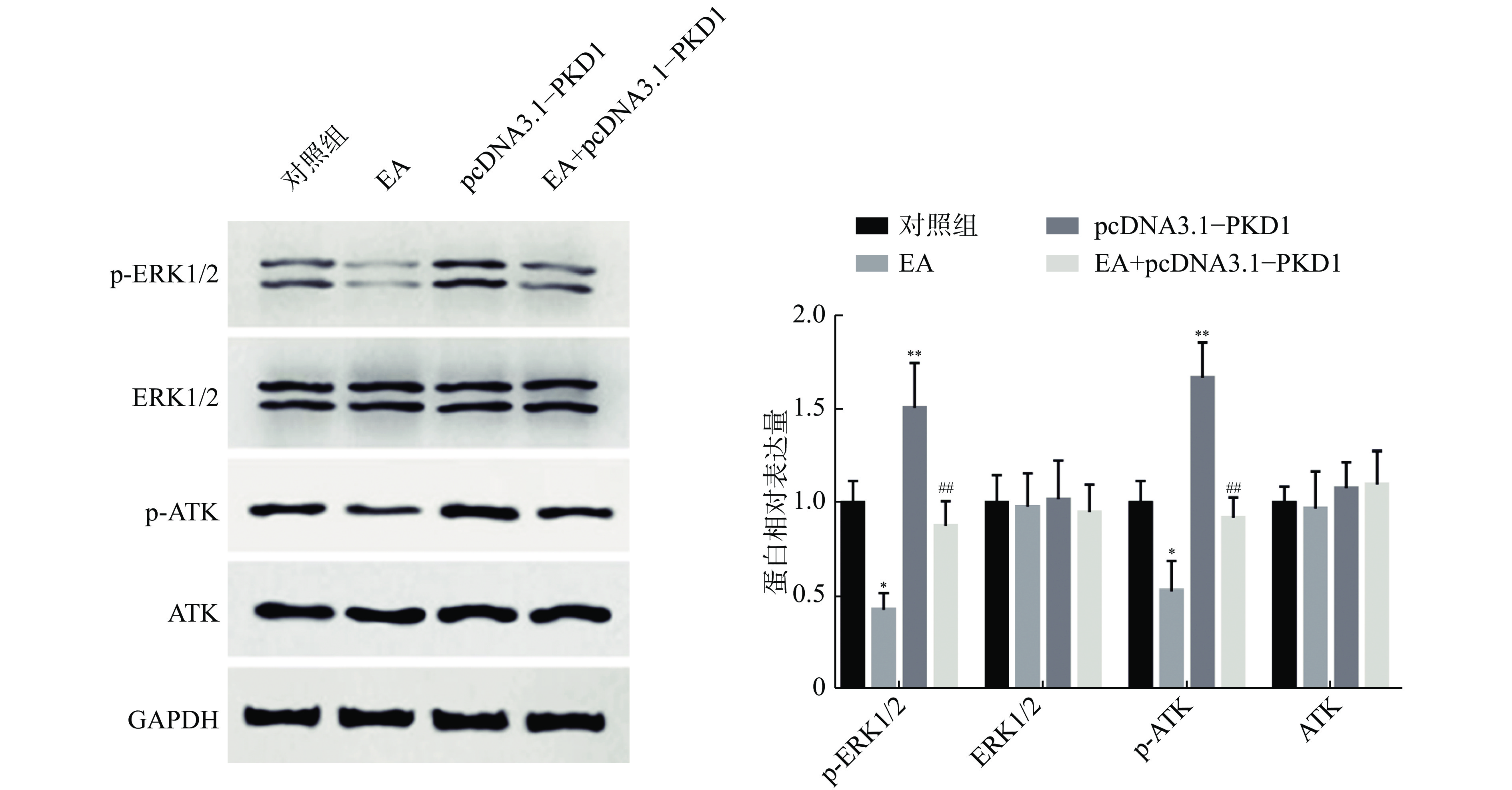-
乳腺癌是最常见的恶性肿瘤之一,近年来已经成为致女性死亡的第二大原因[1]。虽然临床研究人员和基础科学家对乳腺癌进行了广泛研究,同时手术切除、放射性同位素治疗、化学药物治疗、自体免疫细胞治疗、靶向治疗等技术也已经成功应用于乳腺癌患者的治疗[2]。然而,这些传统的治疗方法大多存在副作用,因此有必要寻找新方法来改善患者预后和生活质量。由于中药中含有复杂的化合物,且在多种人体疾病中发挥作用,因此,中药在癌症患者的康复及术后放/化疗的辅助治疗等方面越来越引起人们的关注。
月腺大戟(Euphorbia ebracteolata Hayata)为金虎尾目大戟科大戟属的多年生草本植物,多分布在土坡、草地或者林下。在我国的安徽、河南、江苏、山东、湖北省常见。月腺大戟作为传统中药最早记载于《神农本草经》,到目前为止已经有2 000多年历史,它以根入药,具有逐水祛痰、散结杀虫的功效,可治疗水肿、哮喘、消化不良、皮癣等疾病。近来发现研究中药月腺大戟中的提取物具有抗肿瘤活性。月腺大戟中含有多种化学成分,包括萜类、脂类、酚类、苯乙酮类、黄酮类以及鞣质类。本课题组前期实验中,从月腺大戟中提取了一种乙酰间苯三酚类化合物月腺大戟素A(EA),并证实它能抑制乳腺癌细胞的增殖能力[3-4]。蛋白激酶D1(PKD1)是一种新型的丝氨酸/苏氨酸激酶,在多种癌症组织中异常表达,可以通过作用于MEK/ERK和PI3K/AKT信号通路,调控乳腺癌细胞的增殖能力[5]。但是EA如何影响乳腺癌细胞增殖能力的具体机制,以及是否通过影响PKD1从而影响乳腺癌的增殖能力均不明确。
本研究根据前期实验对EA影响乳腺癌的具体机制的研究,结果表明EA具有通过干扰PKD1介导MEK/ERK和PI3K/AKT信号通路以抑制乳腺癌细胞的增殖能力。
-
人乳腺癌MCF-7细胞(美国模式菌种收集中心,ATCC);DMEM培养基、胎牛血清、青霉素/链霉素双抗溶液(Gibco公司);转染试剂脂质体2000和TRIzol(Invitrogen公司);RNA抽提、反转录、qRT-PCR试剂盒以及BCA蛋白定量试剂盒(北京康为世纪公司);CCK-8试剂(MedChemExpress公司);RIPA裂解液(碧云天公司);PKD1抗体(Santa Cruz Biotechnology公司),P-ERK1/2,ERK1/2,P-AKTAKT,GAPDH抗体(Cell Signaling公司);Western Blot增强化学发光试剂盒(Millipore公司)。PKD1过表达质粒pcDNA3.1-PKD1由Genescript公司构建,载体为pcDNA3.1。中药月腺大戟饮片购自安徽(产地:山东),其中,月腺大戟素A的制备采用课题组前期实验中的方法[4]。
-
人乳腺癌细胞系MCF-7细胞培养在含10%胎牛血清、100 U/ml青霉素和100 μg/ml链霉素溶液的DMEM培养液中,置于37 ℃、5% CO2的饱和湿度培养箱中进行贴壁培养。细胞转染时将处于对数生长期的细胞接种至6孔板中,提前混匀好转染试剂脂质体2000和质粒pcDNA3.1-PKD1或者对照质粒pcDNA3.1,添加至细胞培养板中,混匀后放置培养箱中培养6 h,换正常培养基继续培养。EA药物处理时,首先将处于对数生长期的MCF-7细胞按照1×105个/孔的数目接种到6孔板中,待细胞贴壁后加入不同浓度的EA药物(1、5、10、15、20 μmol/L)处理细胞,待进行后续试验。
-
通过CCK-8实验检测乳腺癌细胞增殖能力的变化。首先,将转染或加药处理的细胞按照每孔接种104/100 μl的浓度接种至96孔板中,每隔24 h检测一次,连续检测3 d,同时每个处理组在每个时间点均设置3个复孔,便于统计分析。每次检测前向96孔板中添加10 μl CCK-8试剂,在培养箱中孵育1 h后,放置酶标仪中震荡1 min,检测其在450 nm处的吸光值(OD)。统计3 d的OD值评估细胞增殖能力的变化。
-
通过qRT-PCR实验检测乳腺癌细胞中mRNA的表达。在转染或加药处理的孔板中添加TRIzol试剂,放置4 ℃摇床震荡5 min保证细胞充分裂解。利用抽提试剂盒提取细胞中的总RNA,并将其反转录为cDNA,根据qRT-PCR试剂盒说明书在ABI 7300实时PCR系统上进行qRT-PCR检测。反应过程中以GAPDH作为内参,计算PKD1的相对表达量。反应中的引物序列为:PKD1,reverse, 5’-CCCACGTGATGGACTCAAAGA-3’ forward, 5’-AAGGGTACGGGCCTCTCAAA-3’;GAPDH,reverse, 5’-AGGGGTCTACATGGCAACTG-3’和forward: 5’-GGCCTCCAAGGAGTAAGACC-3’。
-
通过Western Blot检测细胞加药或转染后相关蛋白的表达。将加药或者转染处理好的细胞加入RIPA裂解液裂解提取总蛋白。收集细胞裂解液,按照BCA蛋白定量试剂盒的说明书检测蛋白浓度。垂直电泳槽上样的每孔中加25 μg蛋白进行凝胶电泳分离,电压设置为80 V;待分离完成后将蛋白从凝胶中转至PVDF膜,电压设置为110 V,时间为120 min。转膜结束后将PVDF膜放置5%脱脂牛奶中进行封闭2 h;在4 ℃摇床中孵育一抗过夜(GAPDH以1:5 000稀释,PKD1以1:500稀释,其他抗体均按照1:1 000稀释),用TBST洗膜3次,每次10 min;室温摇床中用带有HRP标记的二抗(羊抗兔IgG或者羊抗鼠IgG均按照1:10 000稀释)孵育1 h,用TBST洗膜3次,每次10 min;用ECL显影液进行显影。
-
数据统计和分析均采用SPSS 20.0和GraphPad Prism 7.0软件进行,数据以(
${{\overline x} \pm s} $ )表示。采用Student’s t test和单因素方差分析进行组间差异的比较。检验水准(α)为0.05。 -
根据前期实验以及报道,推测EA通过调控PKD1的表达影响乳腺癌细胞的增殖能力,因此,在本研究中首先分析经不同浓度EA处理的乳腺癌细胞中PKD1蛋白水平的变化。结果如图1所示,EA显著抑制乳腺癌细胞中PKD1蛋白的表达水平(P< 0.05),且这种抑制呈剂量依赖性。同时,根据此实验结果EA在15 μmol/L时能显著降低PKD1的表达,故采用此浓度进行后续研究。
-
为了进一步研究EA是否通过PKD1调控乳腺癌细胞的增殖能力,课题组首先检测了EA的加药效果及过表达PKD1质粒是否转染成功。结果如图2A、图2B所示:乳腺癌细胞转染过表达质粒后PKD1的mRNA和蛋白水平显著升高(P<0.001)。结果证实过表达PKD1的转染效率较高。研究还发现EA干预处理后PKD1在mRNA和蛋白水平上均受到抑制(P<0.001),但是此抑制作用在转染过表达PKD1后被显著逆转(P< 0.001)。即PKD1能逆转EA对乳腺癌细胞中PKD1表达的抑制作用。通过CCK-8实验进一步验证EA是否通过PKD1影响乳腺癌细胞的增殖能力。结果如图2C所示,过表达PKD1后细胞的增殖能力显著升高。而EA药物干预后乳腺癌细胞的增殖能力显著被抑制(P< 0.01),当转染过表达质粒PKD1后,EA对乳腺癌细胞的增殖抑制作用被显著逆转(P<0.01)。
-
为了进一步阐明EA如何通过干扰PKD1影响乳腺癌细胞的体外增殖能力,课题组研究了PKD1调控的MEK/ERK和PI3K/AKT信号通路的变化。如图3所示:乳腺癌细胞过表达PKD1后,p-ERK1/2、p-AKT表达水平显著升高(P<0.01);当EA药物处理后p-ERK1/2、p-AKT表达水平显著降低(P< 0.05)。然而对PKD1过表达的细胞给予EA药物处理后,PKD1能显著恢复EA药物处理对MEK/ERK和PI3K/AKT信号通路中关键蛋白表达水平的影响。实验结果证实了EA可能通过调控PKD1介导的MEK/ERK和PI3K/AKT信号通路来影响乳腺细胞的增殖能力。
-
虽然近年来在乳腺癌的早期发现和治疗中取得了重大进展,但是乳腺癌患者的5年生存率仍然较低。基于中药的中医治疗在过去几十年中已得到越来越多的应用,并因其在增强化疗过程中的功效和降低毒性方面的重要作用而被关注,并且在多种癌症的预防和治疗方面具有一定作用[6-7]。据估计,美国国家癌症研究所(NCI)每年在中医相关研究项目上花费约1.2亿美元[8]。乳腺癌患者的治疗除了手术、放射疗法、化学疗法以外,还经常将中药治疗视为一种治疗方法[9]。
EA是从中药月腺大戟中提取的乙酰间苯三酚类化合物。在前期研究结果中证实EA可以抑制乳腺癌细胞的增殖能力。蛋白激酶D(PKD)是一个进化保守的蛋白激酶家族,具有不同PKC家族成员的结构酶学和调控特性。PKD1是其中研究最多的家族成员。研究发现PKD1可以通过作用于MEK/ERK和PI3K/AKT信号通路调控乳腺癌细胞的增殖能力[5]。因此,在本研究中首先验证了EA是否会影响PKD1的表达。结果显示EA呈剂量依赖的方式抑制乳腺癌细胞中PKD1蛋白表达。为了进一步证实EA是否通过影响PKD1的表达来调控乳腺癌细胞的增殖能力,课题组体外构建了PKD1过表达质粒转染乳腺癌细胞。在证实转染效率较高后,发现PKD1过表达能够逆转EA在mRNA和蛋白水平上对PKD1的抑制作用。同时,EA能显著抑制乳腺癌细胞的增殖能力,这与前期研究结果一致。然而,原本受EA干预而降低的细胞增殖能力在PKD1过表达的情况下被显著逆转,证实PKD1能逆转EA对乳腺癌细胞的增殖抑制作用。
最后,课题组对EA如何通过干扰PKD1影响乳腺癌细胞增殖能力的机制进一步研究。既往的研究已经证明PKD1可以通过作用于MEK/ERK和PI3K/AKT信号通路调控乳腺癌细胞的增殖能力[10]。因此,我们分析了MEK/ERK和PI3K/AKT信号通路中关键蛋白的变化。实验结果证实EA药物作用于乳腺癌细胞时p-ERK1/2、p-AKT表达水平显著降低,说明EA能抑制MEK/ERK和PI3K/AKT信号通路活性。但是,当EA药物和PKD1过表达同时处理时,PKD1过表达能显著恢复EA对p-ERK1/2、p-AKT的抑制作用。实验结果证实EA可能通过干扰PKD1介导MAPK和PI3K/AKT信号通路活性,从而抑制了乳腺癌细胞增殖。
此外,肿瘤的发生和发展是一个复杂的过程,本研究证实PKD1能显著促进乳腺癌细胞的增殖能力,这与已有的文献报道中PKD1会促进乳腺癌细胞增殖能力的结果是吻合的。但是在其他文献中报道过表达PKD1会显著抑制乳腺癌细胞的迁移和侵袭过程[11]。也就是说在肿瘤发生转移和侵袭前,肿瘤细胞大量增殖的阶段可以通过药物抑制PKD1的表达和活性,从而抑制肿瘤细胞的增殖。因此,在乳腺癌发生转移和侵袭前,使用EA抑制PKD1的表达和活性,可能具有抑制乳腺癌细胞增殖的功能。但是,如果肿瘤发生转移和侵袭后,药物抑制PKD1的表达,可能会产生促进肿瘤转移和侵袭的结果,使得肿瘤疾病向更加恶化的方向发展。因此,EA在乳腺癌中的应用应该严格注意肿瘤病理状态,在未发生转移和侵袭的患者中EA可通过抑制PKD1发挥抗肿瘤作用,而在已发生肿瘤转移和侵袭的患者中则应该谨慎使用调控PKD1的药物。
综上所述,经过一系列研究证实EA以剂量依赖的方式抑制乳腺癌细胞中PKD1的表达,而PKD1过表达能恢复EA对乳腺癌细胞增殖能力的抑制作用。同时,EA可能通过干扰PKD1介导的MEK/ERK和PI3K/AKT信号通路的活性抑制乳腺癌细胞的增殖能力。总之,本研究首次揭示了EA药物通过抑制PKD1的表达及其介导的MEK/ERK和PI3K/AKT信号通路发挥抑制乳腺癌细胞的增殖作用。
Inhibition of ebracteolatain A in the proliferation of breast cancer cells by interfering with PKD1-mediated MEK/ERK and PI3K/AKT signaling pathways
-
摘要:
目的 乳腺癌是世界上最致命的恶性肿瘤之一。月腺大戟素A(EA)是从中药月腺大戟中提取的乙酰间苯三酚类化合物。探讨EA抑制乳腺癌细胞MCF-7增殖的具体机制,以期为乳腺癌的临床治疗提供新的思路。 方法 在乳腺癌细胞MCF-7中添加不同浓度的EA药物,检测PKD1蛋白表达水平的变化。构建PKD1的过表达质粒体并转染至细胞,用实时荧光定量PCR技术和Western Blot实验检测PKD1的mRNA和蛋白表达水平。CCK-8实验用于检测细胞增殖能力的变化。Western Blot实验用于检测PKD1介导的相关信号通路中关键蛋白的表达水平。 结果 EA以剂量依赖的方式抑制乳腺癌细胞中PKD1蛋白的表达(P< 0.05)。当转染过表达质粒后,PKD1在mRNA和蛋白水平上显著升高(P< 0.001)。同时过表达PKD1显著逆转EA对MCF-7的增殖抑制作用(P<0.001)。信号通路分析证实EA通过抑制PKD1介导的MEK/ERK和PI3K/AKT信号通路活性影响乳腺癌细胞的增殖能力(P<0.05)。 结论 EA通过调控PKD1介导MEK/ERK和PI3K/AKT信号通路,能够抑制乳腺癌细胞的增殖。 Abstract:Objective Breast cancer is one of the deadliest malignancies in the world. ebracteolatain A (EA) is a kind of acetylphloroglucinol extracted from ebracteolatain. To explore the specific mechanism of EA inhibiting the proliferation of breast cancer cell MCF-7, so as to provide a new approach for the clinical treatment of breast cancer. Methods EA with different concentrations were added to breast cancer cell MCF-7 to detect changes in PKD1 protein expression. The plasmid with overexpressed PKD1 was constructed and transfected into cells, and the mRNA and protein expression levels of PKD1 were detected by real-time fluorescence quantitative PCR and Western Blot assay. CCK-8 assay was used to detect changes in cell proliferation capacity. Western Blot assay was used to detect the expression level of PKD1 and its related signaling pathways. Results EA inhibited the expression of PKD1 protein in breast cancer cells with a dose-dependent manner (P< 0.05). When transfected with the overexpressed plasmid, PKD1 was significantly increased in mRNA and protein levels (P<0.001). At the same time, PKD1 overexpression significantly reversed inhibition of EA on MCF-7 proliferation (P<0.001). It was confirmed by signaling pathway analysis that EA might affect the proliferation ability of breast cancer cells by inhibiting PKD1-mediated MEK/ERK and PI3K/AKT signaling activity (P<0.05). Conclusion EA could inhibit the proliferation of breast cancer cells by regulating PKD1-mediated MEK/ERK and PI3K/AKT signaling pathways. -
Key words:
- breast cancer /
- ebracteolatain A /
- PKD1
-
临床药物研究需要严格、标准、规范的数据管理[1],众多文献阐述了统计分析前临床试验数据核查的相关问题及改进措施[1-4],然而,对于统计分析所得数据的核查却鲜有报道。本文以生物等效性(BE)研究为例,介绍统计分析数据核查的要点,包括:试验分组的随机数字表、药代动力学(PK)主要参数以及BE的分析计算数据和结果在相应的软件中是否能够重现、与原统计分析报告是否一致。同时,统计专业人员对核查提出的问题进行敏感性分析,并出具相关报告。
1. 资料与方法
1.1 资料来源
本文所使用的数据来自我部于2019-2021年间所接受的18项BE研究统计分析数据核查的结果,所测试的药物分别为抗病毒、抗菌药物以及治疗心脑血管疾病、糖尿病等疾病的药物。
1.2 统计学方法
1.2.1 采用SAS软件运行得出随机数字表
随机指利用SAS软件中的随机化功能,事先给出种子数,进行随机化分组。该方法简便易行、可重复、符合随机化要求[5]。通过SAS系统的“PROC PLAN SEED=种子数”过程实现两组等比例随机化。例如,将001~010这10个数随机分配为A、B两组,种子数设定为20200506,则生成的结果A组为002、003、006、008和009,B组为001、004、005、007和010。核查时,只要采用试验时设定的种子数,则通过SAS运行得到的A组和B组的数据不变。用同样的随机种子,通过SAS程序运行,能够得出相同的随机表。由此证明研究对象进入试验组和对照组机会均等。
1.2.2 采用WinNonlin软件计算主要PK参数、SAS软件进行BE评价
BE指药学等效制剂或可替换药物在相同的试验条件下,给予相同的剂量,其活性成分吸收速度和程度的差异无统计学意义[6]。BE研究给药后,通过测量不同时间点的生物样本(全血、血浆、血清等)药物浓度,得出药物浓度-时间曲线,经过计算得出血药浓度-时间曲线下面积(AUC)、药物达峰浓度(cmax)、达峰时间(tmax)(图1)等PK参数后,再通过统计学分析比较,判断两种制剂是否生物等效。
目前,BE评价方法是置信区间法。当主要PK参数AUC和cmax的几何均值比值的90%置信区间在80%~125%内时,受试制剂吸收的速度和程度与参比制剂相当,视为生物等效[7]。
核查时,首先需要核对申办方提供的统计分析前的原始数据。统计专业人员向核查人员展示数据传输协议(由申办方提供);然后,根据原始样本浓度数据,现场使用WinNonlin 8.1软件处理各组血药浓度测定数据,采用非房室模型计算出主要PK参数,包括AUC0-t、AUC0-∞、cmax,其他数据则使用SAS 9.4软件分析。如果受试制剂与参比制剂的AUC0-t、AUC0-∞和cmax几何均数比值的90%置信区间均落在80%~125%范围内,则两种制剂生物等效;否则,两种制剂不存在生物等效。将核查所得结果和结论与原统计分析报告核对,检查一致性。
2. 结果
2.1 一般情况
18项BE研究的分组随机数字表均可重现;18项研究均符合生物等效的判定标准,且BE评价结果与原统计分析报告一致;其中有13项研究的PK参数与原统计分析报告相同,其余5项研究的PK参数则有差异,见“2.2”项。
2.2 问题及处理结果
有12项研究存在个别样本采样时间偏差,其中,2项研究被要求补充敏感性分析,3项研究的分析数据集被要求进行受试者数据的重新纳入或剔除后,也进行了敏感性分析。
上述5项研究敏感性分析的结果显示:PK参数AUC0-t、AUC0-∞和cmax的几何均值比值的90%置信区间虽在数值上有所变化,但仍然在80%~125%范围内,维持原统计分析报告的BE评价。
3. 讨论
3.1 BE研究中随机化和等效性评价的意义
BE试验通常采用随机交叉等试验设计,随机和盲法因其有效控制偏倚而成为BE试验注册和核查的关键内容[8]。由于随机化即随机分配的优点,随机对照试验被广泛认为是评价新的药物、新的医疗器械或新的治疗方法疗效的最佳设计[9],是评价医学新疗法的金标准[10]。
在过去的二十年里,许多第一代专利药品的专利和上市许可的到期,导致了仿制药的兴起。进行BE研究被认为是确定仿制药与专利药具有相同的有效性和安全性的关键[7]。BE研究在化学药物仿制药的申请、新药评价以及已上市药物的变更申请中,具有不可替代的作用[6, 8, 11]。
3.2 核查发现的问题
3.2.1 采样时间偏差
在药物临床试验方案中,试验期间各个样本采集的时间点有严格规定。由于操作技术、环境及其它因素的影响,可能导致样本采集的时间与计划采样时间有所偏差、且超过了方案允许的偏差范围,这种情况视为超窗[12]。超窗会否影响统计分析的结果,需要通过敏感性分析予以证明。
敏感性分析指通过改变方法、模型、未测量的变量值等考查结果的改变程度,以确定评估方法的稳健性。敏感性分析结果与主要分析结果一致,表明主要分析的结果稳健,反之亦然[13]。对BE研究而言,考查的关键便是生物等效这一评估结果对PK参数的变化是否敏感。
核查发现,有2项BE研究分别存在个别受试者采血时间超窗问题。例如,在某研究中,某受试者计划采血时间为给药后5 min,方案规定的允许偏差范围为30s之内,但实际采血时间为5min32s,即超窗2s。在原统计分析报告中,PK参数按照计划采血时间加2s,即5min2s计算。核查人员要求按照实际采血时间重新计算主要PK参数,即按照5min32s计算,并做敏感性分析,与原统计分析结果进行比较,考查所得结论的一致性。
由此可见,对样本采集的环节进行严格、科学的管理非常重要。另外,无论采样时间是否存在偏差甚至超窗,应尽可能获取所有数据,真实记录采样时间,并做出敏感性分析报告。
3.2.2 受试者数据重新剔除或纳入
临床试验有效性分析应涵盖随机化分组后的所有受试者,而不仅限于实际完成的受试者数据。按照这种意向性治疗原则所做的分析是最好的分析。
BE研究的统计分析集除全分析集(FAS)和安全数据集(SS)外,最主要的数据集为PK参数集(PKPS)和BE集(BES)[14],BES是推断受试制剂和参比制剂是否生物等效的数据集。
在撰写统计报告时,如果剔除了某受试者数据,或者有受试者出现种种事故但没有被剔除,核查时可能被要求重新纳入或剔除受试者的数据,并进行敏感性分析,以考查是否对最终结果造成影响。例如,某BE试验对照组某受试者第二周期无给药后3.50 h、3.75 h、4.00 h、4.25 h、4.50 h及以后共13个时间段的血药浓度数据,原报告将该受试者纳入PKPS与BES,在核查时,将该受试者第二周期剔除PKPS与BES;或者,原报告将类似受试者剔除PKPS与BES,核查时又将该受试者重新纳入PKPS与BES。
需要注意的是,BE研究通常样本量相对较小,受各种原因数据剔除造成数据缺失的影响相对较大,可能对BE统计分析结果的稳健性带来挑战。因此,BE研究须严格质量管理,事先没有规定的不做剔除处理[11]。
4. 结论
统计分析数据是临床研究结果的呈现,是撰写统计分析报告和临床研究报告的依据。为确保临床研究最终结果和结论没有争议,国家药品监督管理局核查中心对药物临床研究的统计分析数据进行核查非常必要。
本文从统计学角度介绍了BE研究统计分析数据现场核查的主要内容,并对相关统计方法、核查发现的问题、原因和对策进行逐一分析和讨论。考虑到BE研究通常样本量较小,采样时间出现偏差、剔除或纳入数据可能影响统计结果的稳健性,因此,敏感性分析在BE研究中尤为重要,用于评估主要分析结果和结论的稳健性。敏感性分析和主要分析结果一致,则补充、巩固和加强研究结论,进一步证实试验药物的有效性和安全性[15-17]。本文建议,BE研究在统计分析计划的制定与统计分析报告的撰写中,对核查的内容、可能涉及敏感性分析的相关问题,特别是敏感性数据集PKPS和BES的调整,应予以充分考虑,以便在数据分析阶段采用多种敏感性分析方法,综合考虑结果的稳健性,为评估不同制剂临床治疗的可替换性提供扎实的研究数据。
-
[1] GBD Causes Of Death Collaborators. Global, regional, and national age-sex-specific mortality for 282 causes of death in 195 countries and territories, 1980-2017: a systematic analysis for the Global Burden of Disease Study 2017[J]. Lancet,2018,392(10159):1736-1788. doi: 10.1016/S0140-6736(18)32203-7 [2] DESANTIS C E, LIN C C, MARIOTTO A B, et al. Cancer treatment and survivorship statistics, 2014[J]. CA: Cancer J Clin,2014,64(4):252-271. doi: 10.3322/caac.21235 [3] 曹青青, 李盛建, 李云青, 等. 月腺大戟的化学成分及其乳腺癌细胞毒活性研究[J]. 药学实践杂志, 2019, 37(3):309-313. [4] 李盛建, 王莹, 王强利, 等. 月腺大戟素A抗乳腺癌活性[J]. 第二军医大学学报, 2018, 39(7):765-769. [5] EISELER T, DÖPPLER H, YAN I K, et al. Protein kinase D1 regulates matrix metalloproteinase expression and inhibits breast cancer cell invasion[J]. Breast Cancer Res,2009,11(1):R13. doi: 10.1186/bcr2232 [6] GAO S M, LI X Y, DING X, et al. Cepharanthine induces autophagy, apoptosis and cell cycle arrest in breast cancer cells[J]. Cell Physiol Biochem,2017,41(4):1633-1648. doi: 10.1159/000471234 [7] MENG H, PENG N, YU M W, et al. Treatment of triple-negative breast cancer with Chinese herbal medicine: A prospective cohort study protocol[J]. Medicine (Baltimore),2017,96(44):e8408. doi: 10.1097/MD.0000000000008408 [8] QI F H, ZHAO L, ZHOU A Y, et al. The advantages of using traditional Chinese medicine as an adjunctive therapy in the whole course of cancer treatment instead of only terminal stage of cancer[J]. Biosci Trends,2015,9(1):16-34. doi: 10.5582/bst.2015.01019 [9] LI X, YANG G Y, LI X X, et al. Traditional Chinese medicine in cancer care: a review of controlled clinical studies published in Chinese[J]. PLoS One,2013,8(4):e60338. doi: 10.1371/journal.pone.0060338 [10] KARAM M, LEGAY C, AUCLAIR C, et al. Protein kinase D1 stimulates proliferation and enhances tumorigenesis of MCF-7 human breast cancer cells through a MEK/ERK-dependent signaling pathway[J]. Exp Cell Res,2012,318(5):558-569. doi: 10.1016/j.yexcr.2012.01.001 [11] DURAND N, BORGES S, STORZ P. Functional and therapeutic significance of protein kinase D enzymes in invasive breast cancer[J]. Cell Mol Life Sci,2015,72:4369-4382. doi: 10.1007/s00018-015-2011-2 -






 下载:
下载:

 下载:
下载:





